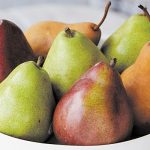November 27, 2019
A Pear a Day
 By Christy Watters, MS, RDN, LDN
By Christy Watters, MS, RDN, LDN
Hy-Vee Registered Dietician
(309) 793-0684
cwatters@hy-vee.com
 If there’s one thing more rewarding than eating a sweet, ripe peach in July, it’s got to be sinking your teeth into a juicy pear in December, otherwise known as National Pear Month. Here’s what you need to know to get the most out of this comforting cold-weather fruit.
If there’s one thing more rewarding than eating a sweet, ripe peach in July, it’s got to be sinking your teeth into a juicy pear in December, otherwise known as National Pear Month. Here’s what you need to know to get the most out of this comforting cold-weather fruit.
Ripeness
Pears are one of the few fruits that don’t ripen on the tree, so they actually get ripe after you buy them. Some pears will at least give you a clue by changing color from green to yellow or by turning a brighter shade of red, but most varieties won’t dramatically change color. For many pears, you can “check the neck” by gently pressing the stem end of the pear with your thumb. If it feels soft, your pear is ripe and ready to eat.
Varieties
There are 10 varieties of USA pears, ranging in color from green to brown to red. Try different varieties to see which ones you like best.
- Green Anjou: These have an egg-shaped appearance, bright green color, and are juicy when ripe with a subtle sweetness. Green Anjou pears are great for baking, poaching, and
roasting because they hold their shape well. - Red Anjou: Similar in shape to Green Anjou, these pears can be recognized by their dark maroon color. Use them as you would Green Anjou pears, and to bring a vibrant color to your dish.
- Bartlett: These pears have a more
traditional pear shape and are known for their aromatics. Barlett pears tell us when they’re ripe by changing from green to yellowish in color. Because of their sweetness and juiciness, Bartlett pears are often used for snacking or canning. - Red Bartlett: With the exception of their color, Red Bartlett pears share the same characteristics of regular Bartlett pears, even changing shades to a brighter red as they ripen.
- Bosc: These pears have an elongated neck and cinnamon-brown color. Bosc pears become sweet early in the ripening process, meaning you can enjoy their honey-like flavor even before the fruit starts to soften.
- Comice: With a rotund base and short neck, these pears can often be identified by their shorter, rounder appearance. Most of them are green; however, some have a reddish covering, and certain newer varieties are completely red. Because of their extreme juiciness and flavor, many people prefer to eat them raw or with a cheese board, as they pair well with Brie, Camembert, or blue cheeses.
- Concorde: With an exceptionally long neck, Concorde pears can be identified by their stretched-out appearance. Like Bosc pears, these pears can be sweet and flavorful while still firm. Because of this, Concorde pears are a great multipurpose pear for cooking or snacking.
- Forelle: These are one of the smallest varieties of pears and have a unique red and green freckled appearance. Interestingly, the green portions will start to turn yellow as the pear ripens. Because of their color pattern, these pears are great for showing off in salads or on fruit trays.
- Seckel: Also very small, Seckel pears are practically bite-sized. Their skin is typically olive green with a reddish hues. Because of their petite bodies, these pears are perfect for lunchboxes or can be canned whole.
- Starkrimson: Named for their crimson color, Starkrimson pears are sometimes labeled as simply Red Pears. They develop a sweet floral aroma as they ripen and are often used in recipes that show off their bright exterior.
Nutrition
A pear a day … It’s too bad that’s not the saying. Because pears are just as powerful as apples at keeping the doctor away. In fact, one medium-sized pear has about 100 calories and 6 grams of fiber—about 24 percent of the Daily Value. Fiber is what helps us feel full for longer while promoting gut and heart health. According to the Dietary Guidelines for Americans, adults should aim for 2 cups of fruit per day. Since one pear is equal to a cup, you’ll be halfway there with this sweet and juicy snack.
RECIPE
Smoky Paprika Sheet-Pan Chicken with Pears, Potatoes, and Carrots

Serves 4 to 6
Ingredients
1 tablespoon smoked paprika
1 tablespoon ground cumin
2 teaspoons garlic powder
2 teaspoons kosher salt
1/2 teaspoon freshly ground black pepper
1 pound ripe or slightly underripe USA Bosc, Concorde, Forelle, or Seckel Pears
1 pound small potatoes in a variety of colors, halved
12 ounces baby carrots, tops trimmed and halved, or larger carrots, peeled, halved, and cut into 3-inch segments
2 tablespoons extra-virgin olive oil
6 bone-in, skin-on chicken thighs, patted dry with paper towels
1/4 cup coarsely chopped fresh cilantro
Sour cream, for serving
Directions
Preheat oven to 425˚F with rack in bottom third.
In small bowl, mix first five spices; set aside.
On a rimmed baking sheet, combine pears, potatoes, and carrots. Drizzle with 1 tbsp olive oil, sprinkle with 1/3 spice mixture, and toss to coat. Spread pears and vegetables out in even layer. Rub chicken thighs with remaining 1 tbsp of oil. Sprinkle both sides with remaining spices. Place chicken over pears and vegetables, spacing evenly.
Roast until an internal temperature of chicken is 170 to 175˚F on instant-read thermometer, 40 to 45 min.
Transfer chicken to platter and tent with foil to keep warm. Switch oven to broil, and place sheet pan on a rack positioned about 6-inches below the heating element. Broil pears and vegetables until lightly browned, about 5 minutes.
Divide pears and vegetables among plates; top with chicken, cilantro and sour cream.
Nutritional information per serving: 240 calories, 8g total fat, 1.5g saturated fat, 65mg cholesterol, 760mg sodium, 26g total carbohydrate, 6g dietary fiber, 11g sugar, 16g protein.
Chrissy Watters, MS, RDN, LDN is a registered dietician
at Hy-Vee. She can be reached at (309) 793-0684 or at
cwatters@hy-vee.com.


